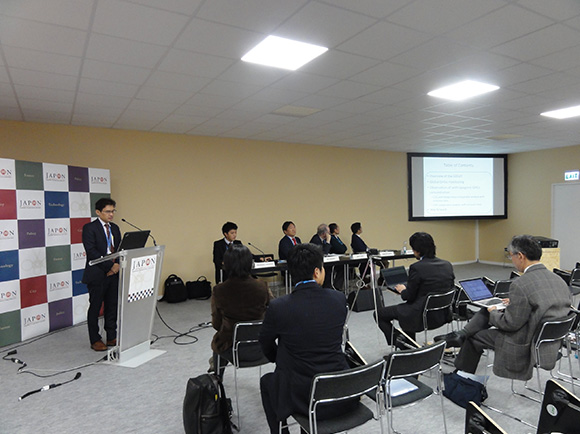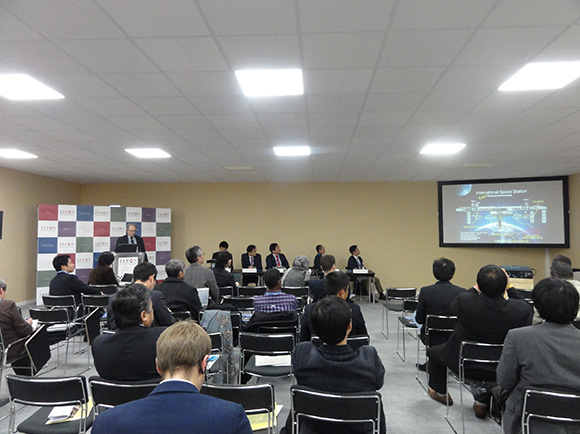Global Carbon Monitoring – towards Modeling, Projection and Policy Decision
Japan Aerospace Exploration Agency (JAXA); Ministry of the Environment, Japan; National Institute for Environmental Studies (NIES); National Aeronautics and Space Administration (NASA)
Outline
In order to better predict and take measures for climate change, it is necessary to understand the current situation. For that satellites play an important role by globally monitoring carbon in the atmosphere.
Japan Aerospace Exploration Agency (JAXA) is operating Greenhouse gases Observing SATellite (GOSAT), which was developed jointly by National Institute for Environmental Studies, Japan (NIES) and Ministry of the Environment, Japan, and its main objective is to estimate the carbon balance on a global scale. In December, 2014, GOSAT showed positive correlations between man-made CO2 concentrations in the sky of world metropolises and the concentrations estimated from data for fossil fuel consumption, indicating its potential application for verification of man-made greenhouse gases emissions.
Based on these results, we are aiming to monitor greenhouse gases emissions from large sources such as metropolitan areas and factories by GOSAT-2, which we are developing at the moment.
Also, it is expected that collaboration with the OCO-2, the US observation satellite, will enable us to develop each country’s technology much further and to contribute to world’s efforts to mitigate global warming.
In this event, we will introduce the latest trend of greenhouse gases monitoring by US-Japan satellites and future projections by climate model based on carbon observation, as well as their contribution to global warming mitigation.
Program
-
- Carbon Monitoring Strategy for Environmental Policy Making in Japan (TBD)
- Dr. Akio Takemoto, Director, Research and Information Office, Ministry of the Environment, Japan
-
- Space-borne Atmospheric GHG Monitoring Project in Japan (TBD)
- Dr. Kei Shiomi, Researcher, Earth Observation Research Center, JAXA, Japan
-
- NASA Studies of the Earth’s Carbon Cycle: From Observations to Products
- Dr. Jack Kaye, Associate Director for Research, Earth Science Division, NASA, U.S.
-
- Application of GHG Observation for Carbon Flux Modeling (TBD)
- Dr. Makoto Saito, Researcher, National Institute for Environmental Studies, Japan
-
- Climate Change Projections with Carbon Cycle: Earth System Models
- Dr. Tomohiro Hajima, Research Scientist, Department of Integrated Climate Change Projection Research, Japan Agency for Marine-Earth Science and Technology, Japan
-
- Q&A
Summary
In this side event, speakers introduced current status of greenhouse gases observation by satellites and airplanes and outcomes of climate change projection.
Japanese “GOSAT” satellite has been measuring concentration of CO2 and CH4 with high accuracy. Monthly overage of CO2 has been increased since 2009 and its trend line seems to reach 400 ppm in 2016. GOSAT-2 is now under development and will be launched in early 2018 in order to provide continuous data. NASA has been conducting greenhouse gases observation by airplanes as well as OCO-2 satellite. They combined data from airplanes, satellites and ground instrument to monitor comprehensive carbon flux. These satellites will continue their observations, collaborating each other.
As impacts of climate change, a number of extreme weather event such as typhoon is being increased and its size is getting bigger. The observation data from satellites is contributing to understanding the impacts of climate change. Regarding projection of future climate, earth system models are being developed because we need to understand interaction of climate and carbon. The result of simulation by model is compared and verified with observation data, and the result introduced in this event was overestimated.
The participants discussed how to bridge scientific data and policy and confirmed the importance of communication between scientists and policy makers.
Key Messages
It is necessary to improve the functions of current satellites and measure concentration of greenhouse gases from national to regional level for better understanding carbon flux. Measurement of greenhouse gases by satellite will contribute to improve the accuracy of inventory which each country submits and even private companies have a possibility to evaluate the result of reducing emission by themselves in the future.
In addition, it is important to bridge the observation data and decisions making. Both scientists and policy makers need efforts to take away barriers between them and fill the gaps. Scientists need to combine data from multiple satellites to analyze accurate information and have enough communication with users.
Photograph
Reporters
Naoko Matsuo, Japan Aerospace Exploration Agency (JAXA)








